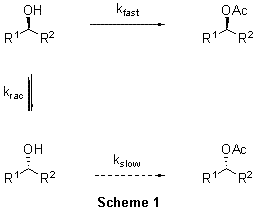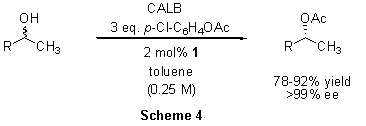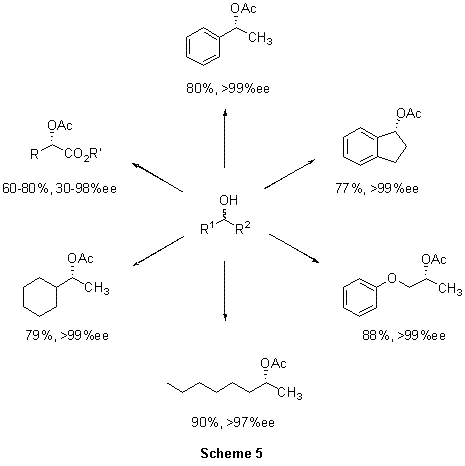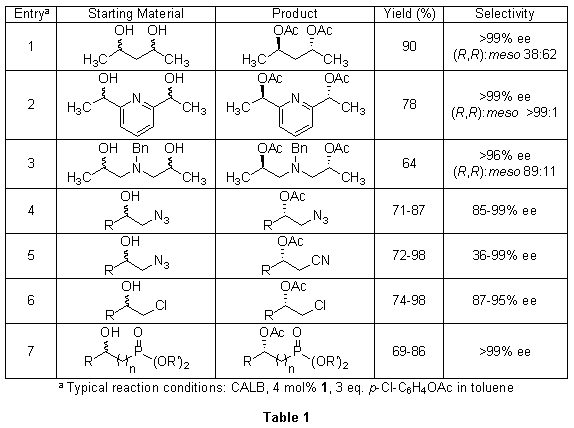Shvo’s Catalyst
In catalytic asymmetric synthesis enzyme-mediated kinetic resolution is an important area. Lipases are particularly successful in kinetic resolutions and hence are manufactured on a commercial scale. However, conventional kinetic resolution has a maximum theoretical yield of 50%. Dynamic kinetic resolution (DKR) circumvents this limitation by epimerizing the slow-reacting enantiomer concurrently with the kinetic resolution. In this way, one enantiomer of the epimerized substrate is converted faster to the product (e.g. by transesterification) by the enzyme, and the yield can theoretically be increased to 100% using DKR (Scheme 1).1

Diruthenium complex 1, first reported by Shvo,2 has found numerous applications as a versatile catalyst in organic synthesis, including the reduction of aldehydes and ketones to alcohols, bimolecular disproportionation reaction of aldehydes to esters, isomerization of allylic alcohols and oxidation of alcohols.3 Under thermal conditions, the Shvo catalyst dissociates into the catalytically active 16-electron species 2 and 18-electron complex 3 (Scheme 2).

Bäckvall has successfully used Shvo’s complex as an efficient epimerization catalyst in several enzyme mediated DKRs.4 In the first step of the proposed epimerization mechanism of secondary alcohols, one of the oxygens on 2 abstracts a proton (removing the need of an external base as cocatalyst) and the ruthenium metal acts as a hydride acceptor, subsequently leading to ketone formation. The ketone generated is then reduced in reverse fashion, resulting in an overall epimerization of the corresponding alcohol (Scheme 3).

The nature of acyl donor is critical to take into account for successful chemoenzymatic DKR, and Bäckvall and co-workers have discovered certain aryl esters are efficient acyl donors in the DKR of several alcohols. An efficient protocol using immobilized Candida antarcticalipase B (CALB) is shown in Scheme 4. Based on the use of CALB in combination with Shvo’s ruthenium catalyst andp-chlorophenyl acetate as acyl donor, a number of secondary alcohols were successfully transesterified and obtained in good to high yields and excellent enantioselectivities (Scheme 5). In the case of the DKR of the racemic a-hydroxy esters, immobilized Pseudomonas cepacia lipase (PS-C) in cyclohexane was used.


The chemoenzymatic DKR was also applied to symmetrical diols, hydroxy esters, azido alcohols, hydroxy nitriles, halo alcohols and hydroxy phosphonates (Table 1). Similarly, using a slightly higher amount of Shvo’s catalyst, various b-hydroxy esters were obtained in a tandem aldol-deracemization-transesterification reaction sequence in good yields and enantioselectivities (Scheme 6).

Materials
To continue reading please sign in or create an account.
Don't Have An Account?